Arcul de Triumf
| Arch of Triumph | |
|---|---|
| Romania | |
 Arcul de Triumf | |
| For the Heroes of the War of Independence and World War I | |
| Unveiled | September 1936 |
| Location |
44°28′1.99″N 26°4′41.06″E / 44.4672194°N 26.0780722°ECoordinates: 44°28′1.99″N 26°4′41.06″E / 44.4672194°N 26.0780722°E near Șoseaua Kiseleff, Bucharest, Romania |
| Designed by | Victor Ștefănescu |
Arcul de Triumf is a triumphal arch located in the northern part of Bucharest, on the Kiseleff Road.
The first, wooden, triumphal arch was built hurriedly, after Romania gained its independence (1878), so that the victorious troops could march under it. Another arch with concrete skeleton and plaster exterior of elaborate sculptures and decoration designed by Petre Antonescu was built on the same site after World War I in 1922. The arch exterior, which had seriously decayed, was replaced in 1935 by the current much more sober Neoclassical design, more closely modelled in the Arc de Triomphe in Paris. The new arch, also designed by Petre Antonescu and executed in stone, was inaugurated on 1 December 1936.
The arch has a height of 27 metres. It has as its foundation a 25 x 11.50 metres rectangle. The sculptures with which the facades are decorated were created by famous Romanian sculptors such as Ion Jalea and Dimitrie Paciurea.
Presently, military parades are held beneath the arch each December 1, with the occasion of Romania's national holiday.
Elisabeta Palace, the current residence of the Romanian Royal Family, is located near the Arch of Triumph, in Herăstrău Park.
Gallery
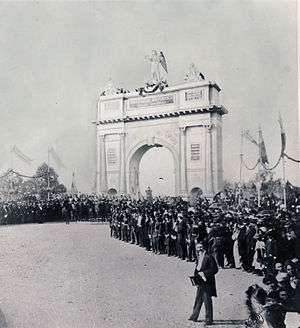 Arcul de Triumf in 1878
Arcul de Triumf in 1878 Vendors near Arcul de Triumf 1923
Vendors near Arcul de Triumf 1923- National Day Parade rehearsals
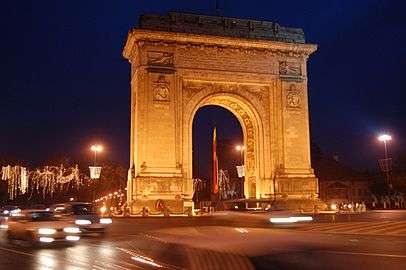 Arcul de Triumf at night
Arcul de Triumf at night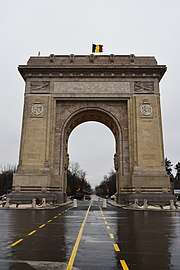 A general view of the Arch (north façade) and Kiseleff Boulevard, after the military parade of December 1, 2017
A general view of the Arch (north façade) and Kiseleff Boulevard, after the military parade of December 1, 2017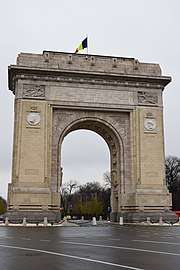 A general view of the Arch, south façade
A general view of the Arch, south façade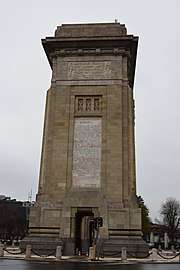 A general view of the Arch, east façade
A general view of the Arch, east façade A general view of the Arch, west façade
A general view of the Arch, west façade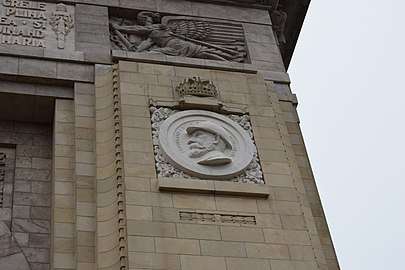 The effigy of HM King Ferdinand I of Romania, on the south façade of the Triumphal Arch in Bucharest ("Arcul de Triumf"). The military victories during WWI and the Great Reunification of Romania (December 1, 1918) took place under the reign of King Ferdinand.
The effigy of HM King Ferdinand I of Romania, on the south façade of the Triumphal Arch in Bucharest ("Arcul de Triumf"). The military victories during WWI and the Great Reunification of Romania (December 1, 1918) took place under the reign of King Ferdinand.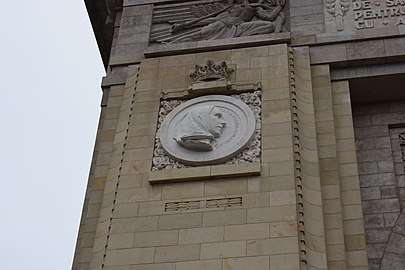 The effigy of HM Queen Marie of Romania, on the south façade of the Triumphal Arch in Bucharest ("Arcul de Triumf"). The Queen is specially praised for her role during and after WWI.
The effigy of HM Queen Marie of Romania, on the south façade of the Triumphal Arch in Bucharest ("Arcul de Triumf"). The Queen is specially praised for her role during and after WWI. An older (pre-1922) form of the Romanian Royal Coat of Arms (medium variant), as depicted under the Arch. The Coat of Arms appears twice under the Arch, on the western and eastern sides.
An older (pre-1922) form of the Romanian Royal Coat of Arms (medium variant), as depicted under the Arch. The Coat of Arms appears twice under the Arch, on the western and eastern sides. The Royal Coat of Arms, western side.
The Royal Coat of Arms, western side.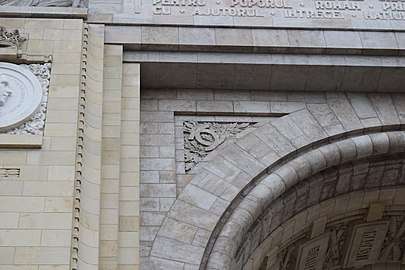 The Royal Cypher of HM King Carol II of Romania (two opposed, intersected and crowned capital Cs), as seen on the south façade of the Arch of Triumph in Bucharest ("Arcul de Triumf"). The current form of the Arch was built under Carol's reign.
The Royal Cypher of HM King Carol II of Romania (two opposed, intersected and crowned capital Cs), as seen on the south façade of the Arch of Triumph in Bucharest ("Arcul de Triumf"). The current form of the Arch was built under Carol's reign. The symbol of the Royal Crown (the Romanian "Steel Crown"), depicted on the eastern façade of the Triumphal Arch ("Arcul de Triumf") in Bucharest.
The symbol of the Royal Crown (the Romanian "Steel Crown"), depicted on the eastern façade of the Triumphal Arch ("Arcul de Triumf") in Bucharest.
See also
References
External links
| Wikimedia Commons has media related to Arcul de Triumf. |